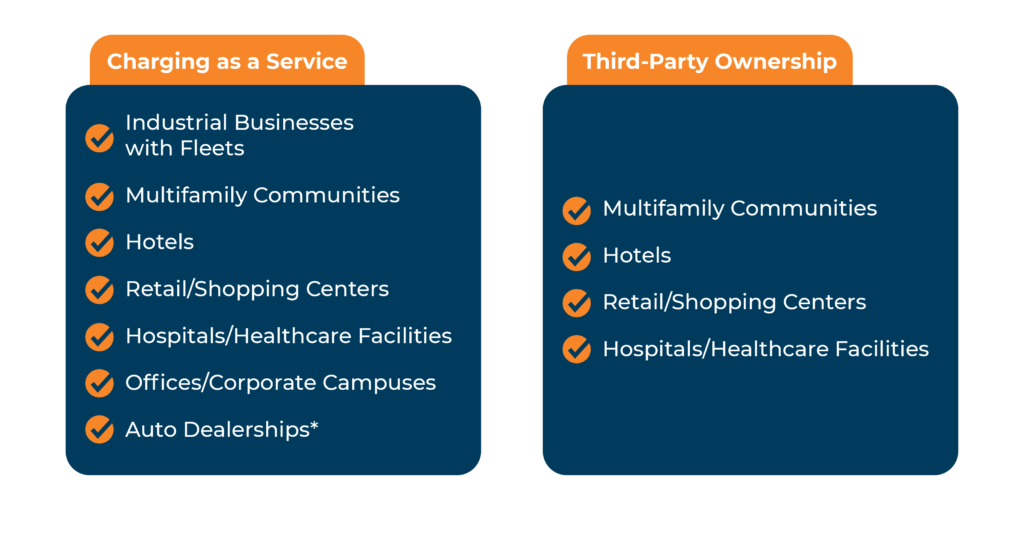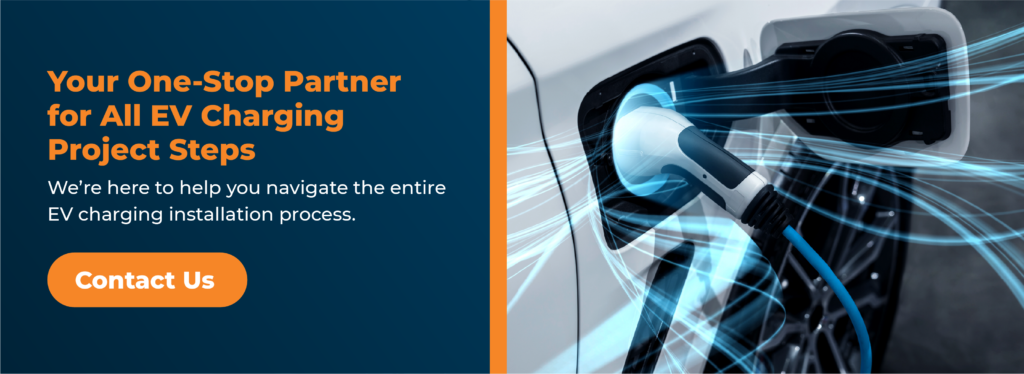
Electric vehicle (EV) sales continue to grow, with no signs of a slowdown. In 2024, EV sales hit an all-time annual high of 1.3 million vehicles sold, a 7.3% year-over-year growth.
Increased sales continue to gain momentum thanks to:
- A drop in the average cost of EVs, making them more affordable.
- More manufacturers have released EV models, compared to luxury-only brands in the past.
- The pool of used EVs continues to grow.
- Attractive incentives help offset the cost of EVs and/or charging infrastructure.
Even as new administration policies have made some question the future of electric, Cox Automotive predicts a strong 2025, with EVs making up a total of 10% of all vehicle sales.
But while EV sales continue to grow, one major gap still remains: Public charging infrastructure.
The U.S. Department of Energy estimates that a staggering 80% of all EV charging happens at home. But for millions across the U.S. that don’t reside in a single-family home, EV ownership can only become a reality with access to convenient and reliable public charging stations.
Business owners have an opportunity to help close the infrastructure gap with on-site charging stations, but many face financial hurdles in covering upfront costs.
The good news: There are solutions to implement on-site EV chargers with zero capital expenditure (CapEx), with some options even offering a new stream of revenue.
Why Should Business Owners Consider No CapEx Models for EV Infrastructure?
Investing in EV charging infrastructure is a strategic decision that can attract more customers, visitors, or tenants to your properties, and help you meet regulations or sustainability goals. But it does come with a price tag.
A no-CapEx approach removes that burden, making it possible to implement charging stations without taking on financial risk. Instead of purchasing and maintaining chargers themselves, businesses can leverage third-party funding models that cover the upfront, ongoing, or in some cases, all costs.
Here’s why businesses should consider a no-CapEx approach:
- Preserve cash flow: No CapEx models eliminate the need for a large upfront cash purchase, allowing businesses to allocate funds to other priorities.
- Avoid budget hurdles: Many businesses face long approval processes for capital expenditures. A no-CapEx model allows you to bypass these delays and avoid taking on financial liability on a balance sheet.
- Minimize risk: No CapEx models shift the burden of maintenance, upgrades, and technology updates away from your business, ensuring you always have well-maintained, updated chargers without the need for additional investment.
- Fast-track implementation: Without the need for internal budget approvals, your business can move faster to install charging infrastructure, keeping up with market demand and customer expectations.
- Future-proof your business: As consumer preferences continue to shift towards sustainability, having EV charging infrastructure in place now ensures you’re ahead of the curve instead of playing catch-up later.

What No-CapEx Solutions Exist for EV Charging Infrastructure?
There are financing models available that allow businesses to deploy EV infrastructure without the need for upfront or ongoing investment.
1. Charging as a Service (CaaS)
A CaaS approach allows businesses to install EV charging infrastructure through an ongoing subscription-based model. A third-party provider covers all upfront costs—including hardware, software, installation, and maintenance—while the business pays a fixed monthly or per-use fee.
CaaS offers predictable ongoing expenses with no upfront investment and removes the risk of ownership. This model gives the business owner decision-making authority, including charger brand, installation location, number of chargers, and more.
A CaaS model is also an excellent option for business owners that view EV charging as a revenue-generating opportunity. You retain most of the revenue collected each time the charger is used.
2. Third-Party Ownership
Under a third-party ownership model, an outside party owns and operates the charging stations at your property. They handle all installation, maintenance, and upgrades, while your business provides the space for the charging stations with no upfront or ongoing costs. This option also eliminates all owner responsibilities, as the burden of upkeep is on the third-party operator.
With this model, third-party providers may be selective about which locations or properties qualify for installation. The provider is also responsible for most decision making, which could limit your choices for charging equipment brand, placement at your business, technology upgrades, and more.
Which Types of Businesses Should Explore No-CapEx Strategies?
While most businesses could benefit from installing EV charging stations, some are a better fit for no-CapEx models.
CaaS is the best fit for businesses with high customer or employee demand for charging but that lack budget to invest in infrastructure. Third-party ownership is a solid option for businesses with high-traffic locations where EV charging demand is strong.

*Auto dealerships that would prefer to charge (vs offering as a free amenity) customers or visitors for charging usage could consider CaaS.
**Keep in mind that locations that are in high-traffic and/or high EV adoption areas are better suited for a third-party ownership model due to owner qualifications.
Your Partner for Every Step of the EV Charging Process
SitelogIQ is your one-stop partner for all project phases of EV charging installation. In addition to being your consultant and contractor, we’re also a strategic partner that manages all phases of a project from planning and utility coordination, to installation and incentive management.
We sit on your side of the table and act as your agent in the marketplace across legal, financing, and hardware / software vendor selection. We’ll handle the financing homework for you with a vetted list of both CaaS and third-party operator partners. With no vendor biases, you get a transparent strategy that is best fit for your needs and goals.
We’re here to help you navigate the entire EV charging installation process. Let’s chat about your needs today.







